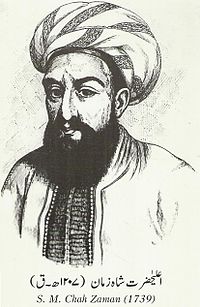Zaman Shah Durrani
This article needs additional citations for verification. (June 2014) |
| Zaman Shah Durrani | |||||
|---|---|---|---|---|---|
| King of Afghanistan | |||||
 Sketch work of Zaman Shah Durrani | |||||
| Reign | Durrani Empire: 1793–1800 | ||||
| Predecessor | Timur Shah Durrani | ||||
| Successor | Mahmud Shah Durrani | ||||
| Born | 1770 | ||||
| Died | 1844 | ||||
| |||||
| Dynasty | Durrani dynasty | ||||
| Father | Timur Shah Durrani | ||||
Zaman Shah Durrani, (Pashto, Persian, Urdu, Arabic: زماں شاہ درانی), (c. 1770 – 1844) was ruler of the Durrani Empire from 1793 until 1800. He was the grandson of Ahmad Shah Durrani and the fifth son of Timur Shah Durrani. An ethnic Pashtun like the rest of his family and Durrani rulers, Zaman Shah became the third King of Afghanistan.
Early years

He seized the throne of the Durrani Empire on the death of his father, Timur Shah. He defeated his rivals, his brothers, with the help of Sardar Payenda Khan, chief of the Barakzais. He extracted an oath of allegiance from the final challenger, Mahmud, and in return relinquished the governorship of Herat. In so doing, he divided the power base between Herat and his own government in Kabul, a division which was to remain in place for a century. Kabul was the primary base of power, while Herat maintained a state of quasi-independence. Kandahar was fought over for the spoils.
During his reign he tried to combine his dispersed relatives together who were deported by his father Timur Shah. His uncle Saifullah Khan Durrani, his sons Mohammad Umar, Bashir Ahmad Khan and Shams Ur Rehman, his cousins Faizullah Khan and Abdullah Khan lived in Akora Khattak[citation needed] in present day Khyber Pakhtunkhwa. They were contacted to come back to Afghanistan but without success. Saifullah Khan died in 1779 and after that the family was led by Faizullah Khan but he disliked the bad habits of Abdullah Khan and Bashir Ahmad Khan and left Akora Khattak and went to Bannu without informing his relatives.[citation needed] Later on, after the death of his wife, Abdullah Khan Durrani migrated to Kohat in 1791 where he married a widow, Pashmina.
Zaman Shah tried his best to recombine his family members and relatives so as to gain power but many of them were living an unknown life. Some of them have even been forgotten their identity.
He attempted to repeat his father's success in India, but his attempts at expansion attempts were failed by the Sikhs and also brought him into conflict with the British. The British induced the Shah of Persia to invade Durrani, thwarting his plans by forcing him to protect his own lands.
In his own lands things went well for Zaman, at least initially. He was able to force Mahmud from Herat and into a Persian exile. However, Mahmud established an alliance with Fateh Khan, with whose support he was able to strike back in 1800, and Zaman had to flee toward Peshawar. But he never made it; on the way, he was captured, blinded and imprisoned in Kabul, in the Bala Hissar. Little information about the rest of his life is available, but he was probably imprisoned for nearly 40 years, until his death, during which time Afghanistan continued to experience much political turmoil.
References
Further reading
- Dalrymple, William (2013). Return of a King. Bloomsbury. ISBN 978-1-4088-3159-5.
{{cite book}}:|access-date=requires|url=(help)
